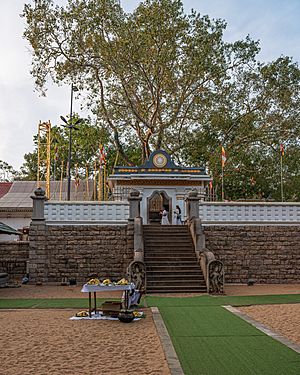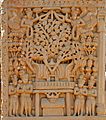Sri Maha Bodhi facts for kids
The Sri Maha Bodhi is a very special tree in Anuradhapura, Sri Lanka. It is a type of tree called a Sacred Fig. The area where this tree grows is known as the Sacred City of Anuradhapura. This city is so important that UNESCO has named it a World Heritage Site.
People believe this tree grew from a small plant, or sapling, taken from the famous Bodhi Tree. This original Bodhi tree is where the first Buddha found enlightenment. The sapling was brought to Sri Lanka by a princess named Sanghamitta and a monk named Mihindu (Mahinda). It was planted way back in 288 BC. This makes it the oldest tree in the world planted by humans that we know the exact planting date for!
The Sri Maha Bodhi tree stands on a high platform, about 6.5 m (21.3 ft) above the ground. It has railings around it to keep it safe. This tree is one of the most sacred things for Buddhists in Sri Lanka. Buddhists all over the world also respect it deeply. A wall was built around the tree by King Kirthi Sri Rajasingha. This wall helped protect the tree from wild elephants.
History of the Sacred Tree
The story of the Sri Maha Bodhi tree began a long time ago. In the 3rd century BC, a sapling from the Buddha's original fig tree was brought to Sri Lanka. This special sapling was carried by Sangamitta. She was the daughter of a powerful ruler named Emperor Ashoka the Great. Sangamitta also started an order of Buddhist nuns in Sri Lanka.
In 280 BC, the Jaya Siri Maha Bodhi sapling was planted. King Devanampiya Tissa planted it in the Mahamevnāwa Park in Anuradhapura. This event was very important for the spread of Buddhism in Sri Lanka.
More About Bodhi Trees
Images for kids
-
The Mahabodhi Tree at the Sri Mahabodhi Temple in Bodh Gaya
-
1810 picture of a small temple beneath the Bodhi tree, Bodh Gaya.
-
Illustration of the temple built by Ashoka the Great at Bodh-Gaya around the Bodhi tree. Sculpture of the Satavahana period at Sanchi, 1st century CE.
-
Ashoka's Mahabodhi Temple and Diamond throne in Bodh Gaya, built circa 250 BCE. The inscription between the Chaitya arches reads: "Bhagavato Sakamunino/ bodho" i.e. "The building round the Bodhi tree of the Holy Sakamuni (Shakyamuni)". Bharhut frieze (circa 100 BCE).
See also
 In Spanish: Árbol de Bodhi para niños
In Spanish: Árbol de Bodhi para niños










